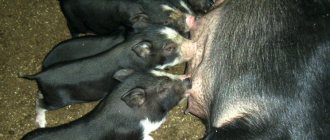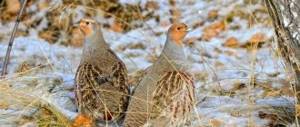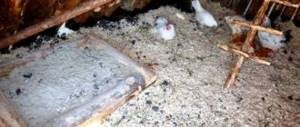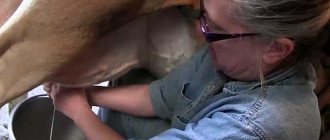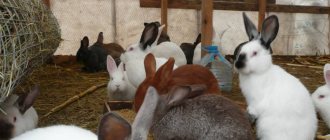Where does the wild bee live?
The main habitats of these insects are areas remote from housing and roads with forest plantations or even shrubs. These types of bees can settle not only in tree hollows, but also on their branches, in rock crevices, and in passages dug in the ground. Sometimes a hive of wild bees can be located in abandoned buildings (under a roof, in an attic) and even near human habitation.
In the territory of the post-Soviet space, the wild honey bee (very rare) lives in its original form in the reserves of Bashkiria. Here, the insects are monitored by professional beekeepers who extract wild honey, which is extremely beneficial for health - after all, for it, little workers collect nectar from the rarest and most distant honey plants. However, the selection of honey is carried out in accordance with a strict rule: no more than 1/3 of all reserves. Otherwise, the family may die.
Important! One of the main conditions when insects choose a place to live is the proximity of a permanent source of water. It is this circumstance that in some cases can force bees to locate close to housing. However, if you know where wild bees live, you can protect yourself and your loved ones from a sudden attack when you discover a nest. After all, the bite of these insects is much more dangerous, since the poison is much more toxic than the poison of domestic bees.
Features of the habitat of wild insects
Such wild and capricious representatives of nature require the following living conditions:
- Sufficient space for overflights.
- Having a private living space.
- A favorable body of water nearby.
- The presence of a large number of honey plants.
Forests are the favorite habitat of wild workers. And yet, as forests are cut down, favorable conditions for them become less and less. Therefore, it is not surprising that sometimes wild bees even settle near human habitation.
As for the living space itself, almost anything can be suitable for them - a hollow tree, a crevice in a rock or ground, the roof of a house, an attic or a garage. These can also be specially created bags of leaves and dry grass that are hung from something. Earthen species even dig a passage in the ground and build a special housing, where the queen is placed at the farthest and most protected point.
This is interesting Treatment of bees with oxalic acid
The issue of wintering for such forest inhabitants is not as pressing as for their domestic counterparts, for whom people come up with various rooms and insulation. A wild bee can withstand frost even at minus 50 degrees! They are very hardy and not picky.
The main condition for wintering is sufficient availability of honey in the hive. And if a person takes all the honey from them or more than a third of the total amount collected, then the bee family has no chance of survival - by spring they will all die. Some species of wild bees that live high in the mountains descend to the lowlands for the winter and hibernate among the trees.
But if you try to catch a wild swarm and populate it in your apiary, then most likely they will die very quickly, since these will be completely uncomfortable conditions for them. Therefore, an attempt to get wild honey by moving insects closer to a human home will be unsuccessful.
Useful properties of honey
Wild bees produce honey, which has the largest amount of useful substances. The process occurs without human intervention, so it matures completely in the hives. Bordeaux honey is highly valued on the world market. Beekeeping products are in great demand.
It contains a lot of bee bread and wax. It is brown in color and has a thick consistency. Does not crystallize for a long time. Much tastier and more aromatic than homemade honey. For its beneficial properties, honey obtained from beetroot is actively used in both traditional and folk medicine. It includes:
- vitamins A, C;
- mineral salts;
- folic acid;
- fructose;
- iodine, etc.
Traditional healers consider it a cure for all diseases. Modern doctors recommend using wild honey to strengthen the immune system. It is also used in the treatment of:
- various colds;
- diseases of the cardiovascular system;
- diseases of the kidneys and gastrointestinal tract.
Honey can improve your appetite!
Dangerous wild bees
Insects living in natural conditions, not tamed by humans, can be very dangerous. They are used to protecting their family and their home from any enemy. Wild bees are more aggressive and can become dangerous to humans. If wild bees have settled near your house or on your summer cottage, you should be careful, as this is a rather unpleasant neighborhood.
Firstly, the noise made by a large number of bees will disturb you.
Secondly, the danger from their bites is many times greater than from domestic insects. Even a person who is not allergic to them can become ill from the sting of one bee. If a person is bitten by several wild bees at once, this can end very sadly. Their poison is much more concentrated than that of pets, and therefore many times more dangerous.
If you are stung by a wild bee, you should call an ambulance or do the following:
- Remove the sting.
- Treat the wound with alcohol.
- In order to remove the poison, the wound must be thoroughly rinsed with salt water.
- After all procedures, apply a cold compress or a piece of ice.
- Drink plenty of fluids that contain ascorbic acid. It could be tea with lemon or rosehip.
Video: honey from wild bees.
Types of wild bees
The main task of insects is to pollinate plants in nature. However, bees are also capable of creating a large number of useful products, which include honey, propolis, wax, and bee bread. There are three groups of representatives from this family:
- Social activists. The structure of a bee colony is almost no different from that of domestic “wards”. The young feed the queen and raise the brood. At the age of 10 days, individuals begin to produce wax for the construction of honeycombs. By 2 weeks of life, bees become cleaners and scavengers. Adult workers are responsible for honey collection.
- Semi-public families. This variety has not yet been studied enough. However, it is known that the primitive structure within the group is distinguished by its widespread distribution. In a bee family, the number of female workers usually does not exceed 15, and in size these individuals are slightly smaller than the queen. The family development cycle lasts a year; fertile females survive after wintering.
- Singles. This type of lifestyle is found quite often in wild insects. The female lays eggs and raises her offspring independently. Singles do not produce honey or wax and pollinate only one type of plant. A common subspecies of the Osmia bee.
Jenter cell
Among the representatives living in free territories there are cuckoo bees. Females lay eggs in other people's nests, which provides comfort and suitable conditions for growth and survival. The reason for the behavior is that the insect does not have sufficiently effective devices for collecting food reserves.
In the group of singletons, the subspecies Osmia lignaria stands out, which has recently been actively cultivated for plant pollination. The reason is that these insects are easier to keep than honey bees. The female lays first female and then male eggs in suitable holes. Afterwards, pollen is placed in the cells and the cavity is sealed with clay or silt. Having completed the work of decorating the nests, the female dies. In the spring the young emerge. Representatives of Osmia Lignaria are distinguished by their peaceful, friendly character.
Features of the genus Apis
Some bee species build a single honeycomb plate. They cannot live inside the hive.
Honeycombs on branches
The number of families in this case will be small. The basis of the structure is tree branches.
Where to find
The table lists the species belonging to the genus Apis.
| Advantage/disadvantage/neutral quality (+/–/0) | ||
| From a general point of view | For the breeder | |
| Aggressiveness | – | |
| Tendency to swarm | – | 0 (or +) |
| Frost resistance | + | + |
| Immunity to certain diseases (see below) | + | + |
| Low theft | + |
Hives should be looked for in tree hollows, as well as in the ground in fields and meadows. It should be noted that Apis Florea is a species that is resistant to high temperatures. In this species, the temperature balance is shifted 10 degrees upward, and the bees feel good even at +50 C.
Species Florea, features
The main habitat for Apis Florea bees is not Siberia or India, but the Persian Gulf.
It is clear that the habitat cannot be the taiga massif. We need honey plants, that is, plants that produce nectar. Insects of the genus Apis settle in the hollows of the following trees: aspen, willow, and less commonly, linden. And giant bee colonies can live in the cracks of aspen or poplar trees. In one fissure, a hive of wild bees was found, the length of which exceeded 5 meters.
Any bee colony consists of a queen bee, tens or hundreds of drones and thousands of workers. Only the latter can sting, but their venom causes allergies. A queen bee can sting another insect. It is distinguished by its increased body length.
The hive can be located hundreds of meters from the reservoir. Then the reservoir is a source of drinking. In June, during haymaking, many hive nests are found in the meadows. And you can notice that there is a source of water nearby. In a forest or shelter belt, this rule is not followed. But the facts are known:
- The lower entrance in a tree with a hollow is located at a height of 5-7 meters;
- Sometimes the height reaches 20 meters;
- Bees can be smoked out through the entrance, but it will not be possible to remove the honeycomb from the hollow.
How to remove honey
To remove honey from the honeycomb, you need to remove the honeycomb from the hive. And if the nest is in a tree, the trunk has to be cut down...
Beehive in an aspen hollow
Everything that is said below is considered poaching:
- All tapholes are sealed with a mixture of clay and water;
- The trunk is cut down;
- Saw the hive in half.
This is the only way to get to the honey, continuously using the smoker.
Forest and even meadow wild honey often turns out to be polyfloral - it consists of nectars of many plants. Properties also depend on the type of insect. Cerana and Apis Mellifera bees live in the hives, and the third hive species is the Kozhevnikov bee.
How to search and catch
You can determine where the nest is located in different ways:
- They track where the bees fly after watering;
- In the spring, before the first flight, everything unnecessary is thrown out of the hive: litter, dead bees, etc. And if the snow has not yet melted, the remains of litter will be visible from afar.
- From the last days of May you can use bait - troughs attached with ropes to poles. Honey is poured into the trough, but it is better to use a mixture of honey and water.
Application of bee larvae
This mixture is called “full” - it is one of the favorite treats of bees.
Trap designs
Sometimes traps are also used. They are divided into two types: those that do not kill individuals and those that kill. The killing trap is an ordinary plastic bottle (see photo).
The trap, not intended for destruction, is placed at a height of 4-5 meters from the ground. The best period for use is June and early July.
Characteristic
Wild individuals have the same body structure as domestic ones:
- two pairs of wings;
- head;
- breast;
- belly;
- paws;
- proboscis;
- sting.
They are also characterized by a hairy covering and a chitinous skeleton. Excellent vision is evidenced by the presence of two compound and three simple eyes. Both females and males have antennae in varying numbers. This organ of smell is endowed with increased sensitivity. Serves to determine the level of heat, humidity, and the presence of carbon dioxide in the nest.
Taste buds are located on the proboscis and paws. The lower lip transformed into a proboscis. The top one looks like a chitinous plate. The sting is located at the end of the abdomen. There are a few nicks on the surface. Therefore, after a bee stings an enemy, it lingers in the body. The bee itself always dies.
What do they eat?
Wild honey plants, like “noble” ones, eat nectar and pollen collected from flowering plants. They prefer trees such as linden and bird cherry. Among the shrubs – viburnum. Herbs include clover, oregano, thyme, angelica, mother and stepmother, chicory, mint, sage.
Where do they spend the winter?
“Free” honey plants spend the winter in their nest. With the onset of the cold season, the house is cleaned. Bees clean out debris, expel drones, and seal honeycombs with wax plugs. Protecting their home from drafts and excessive humidity, insects seal the cracks with propolis.
By the end of autumn, honey plants gather in a large lump. Its density depends on the ambient temperature. The colder it is outside, the denser they cluster. Insects of the upper tier are inactive. Inside, individuals actively move, generating heat. The “core” temperature reaches 350.
Gradually the bees change places. Individuals, moving inside, warm up and begin to generate heat themselves. The family, using food supplies, slowly moves up.
For successful wintering the main conditions must be met:
- strong numerous swarm;
- honey supply;
- preparing the house (absence of draft and dampness);
- peace and quiet around the winter hut.
When metabolism slows down in cold weather, one bee needs up to 7 mg of food per day.
What does a forest bee's nest look like?
The houses of wild families are located in tree hollows. The internal structure always exactly matches the size, shape of the “room” and the location of the taphole.
Construction always starts from the bottom tier. The honeycombs are tightly attached from the sides and top. The bottom is made rounded. A new family rebuilds 5-7 plates. Their size depends on the size of the swarm, location, and time of “building.” However, the distance between the honeycombs is always maintained the same - 12.5 cm.
As the number of individuals increases, the house expands and can grow up to two meters in diameter. The insects will definitely “close” the large hole at the entrance, while the small one will gouge it out.
The lower entrance is located at a height of up to 7 meters. The nest is built on the south side of the trees. There should be a water source nearby. Usually bees choose an old linden tree or aspen tree with a hollow. If the trunk begins to hum when tapped, then the nest is nearby.
Forest bee sting
The concentration of poison in a wild insect is much higher than in a domestic one, so the pain is much stronger. Swelling of the affected area and an increase in the victim's body temperature are possible.
First aid for bites:
- remove the sting;
- squeeze out the poison;
- treat the affected area with any available disinfectant;
- take an antihistamine (Fenkarol, Suprastin, etc.);
- apply a cold compress;
- Drinking plenty of fluids is recommended.
Numerous wild bee stings are dangerous to human life and health. A severe allergic reaction is possible. You should consult a doctor immediately.
Wintering
Strong insects raised in the wild survive wintering well in a hollow. A nest box is an empty cylinder that is located in tree trunks. The bees will carefully polise the top and walls of the tree. This allows you to keep moisture, cold and cold air out of your home. Ventilation occurs through the lower entrance, thoughtfully made by the bees. The club is located at the bottom, and the honeycomb is at the top. There is an air cushion between the honeycomb and the entrance. During wintering in a nest, the residents' metabolism slows down, which allows them to save energy for the spring.
Where do they spend the winter?
The nest serves as the place where the bee colony spends the winter. The arrival of cold weather forces insects to clean out debris, drive out drones, and seal up honeycombs. The cracks are lubricated with propolis to protect against cold and dampness. The main conditions for successfully surviving the winter:
- volumetric feed supply;
- absence of holes, cracks in the house;
- strong, healthy, strong family;
- quiet, calm environment.
By the end of autumn, the swarm unites into a lump. The colder it gets around, the more the ball shrinks. Outside there are inactive individuals, and inside the insects continue to constantly move. The bees in the center of the coma thereby create warmth. Changes occur periodically so that the representatives from the outer shell are heated. The swarm gradually eats food reserves (honey) and moves up the hive along the honeycombs.
Types of wild bees
According to their organization, representatives of the bee species can be divided into several forms:
- Public. In such a family, insects have the same structure as ordinary domestic honey bees. The difference is the level of immunity (higher), greater ability to work, slightly smaller size and the almost complete absence of yellow in color (which is clearly visible in the photo). Some varieties are characterized by a denser fleecy coating and a high level of aggression;
- Semi-public (or primitive-public). These bees have been little studied, but there are many more such varieties. They have small colonies with a minimum of workers (no more than 12), and the worker bee differs from the queen only in size. Such organizations have a one-year development cycle, and only the most fertile females survive the winter;
- Singles. In nature, there are many varieties that lead a solitary lifestyle: one female lays eggs and raises offspring. Such bees do not produce wax or honey, and pollination often occurs according to the type: one type of bee - one type of plant. When a particular species of solitary wild bee disappears, the existence of the corresponding plants is threatened.
Important! Among insects there are parasitic species - cretoparasites or cuckoo bees. By placing their eggs in the nests of other species, they provide them with comfortable conditions for survival and growth, since they themselves do not have sufficiently advanced devices for collecting food. In some cases, the uterus may even change. This deviation occurs among social and solitary bees, real bees and in the bumblebee family.
Differences between wild and domestic bees
We recommend reading our other articles
- Cherry Revna
- Sow farrowing pen
- Cherry variety Fatezh
- Tomato variety Golden Heart
Domestic bees
In their natural environment, wild bees usually live in the same way as domesticated ones, and also observe the characteristics of an ordinary bee colony. At the head of the family is the queen, who lays eggs. She has worker bees under her command, which at different stages of life are responsible for different areas: caring for the queen, caring for the future generation, cleaning the hive, collecting nectar, and so on. In addition, the hive has a certain number of drones, which are responsible for fertilizing the female. However, there are a number of differences between wild insects and domestic ones.
- Wild bees are much more aggressive, sometimes attacking without warning.
- The color of wild bees is calmer, not bright, and can be almost completely gray, without stripes.
- Undomesticated insects are distinguished by their great work ethic. They have an abundance of vitality and are much more active.
- The body of such a bee is smaller, although there are exceptions.
- The immunity of wild bees is stronger and more resilient; it is much easier for them to survive the winter even at -50 degrees.
Features of a wild bee
Almost all wild bees pollinate various types of plants. A special feature of the existence of wild bees is that among them there are both flocks of 20 thousand insects and solitary individuals. Singles pollinate plants, but do not produce honey. Most often, they organize small colonies where about 20 working individuals live. But such families can only exist for 1 year.
Insects are aggressive. At the sight of any danger, a glandular sting is used. The queen and working individuals have it. Even a strong smell or noise can be the causative agent. This is due to a large number of enemies. Many animals are not averse to sweet honey. In such situations, insects often attack the “thief” in a swarm. These are social insects. Among them there are workers, a queen, and drones (males). The division of labor between individuals depends on the age of the insects. There are bees:
- scouts;
- wet nurses;
- pickers, etc.
The main function of drones is to fertilize the uterus. After wintering, they lose the ability to reproduce. Therefore, before the onset of cold weather, other individuals in the swarm drive them out of the hive. The queen lays eggs. The worker bees obey her. They collect nectar, raise brood, etc. They are resistant to most diseases that can affect domestic insects. They can tolerate frosts down to -50. Their poison is more toxic compared to domestic species.
Finnish beehives bibox: description, customer reviews
Honeycombs begin to be built at a young age. The primary task of all bees is to preserve the queen and collect nectar. In search of honey plants, they can fly up to 4 km from their hives. Wild bees cannot be bred at home.
Benefits for nature
There are fewer and fewer wild bees and their species are listed in the Red Book. There are about 20 thousand of their varieties and about half of them are species not domesticated by humans. Scientists cannot even fully study them, since it is difficult to do so. In nature, such a bee most often lives in forest conditions. There are wild honey bees, earth bees, etc.
But no matter what species they belong to, they all perform a very important role - they pollinate plants. Considering that the wild honey plant is much more hardworking and hardy than the domestic one, and can also easily tolerate any weather conditions, it can pollinate plants much more actively. It is thanks to these workers that pollination of all forest plants occurs.
In addition, wild honey bees create honey with a unique composition. It is considered the most valuable of all bee products and can cure almost any modern human disease. True, it is very difficult to find such honey, because due to deforestation and the destruction of bee nests, their numbers are sharply decreasing. Today, wild honey bees can be found for the most part only in special reserves.
The most famous is in Bashkiria - Shulgan-Tash, where they simultaneously protect this endangered species of insects and extract honey from wild bees. This kind of beekeeping is called beekeeping. In order for the bee colony to have a chance to survive during the winter, people take only a third of their honey once a year.
Dangerous neighborhood
Despite the environmental benefits and extremely useful products produced, wild bees can become a source of mortal danger if they settle near a home. Even domesticated species of insects pose a threat in the event of a massive attack, and wild ones are doubly or triple so.
However, destroying wild bee populations is the wrong decision, since many of their species are listed in the Red Book, and the little workers themselves just want to be left alone.
If the veterinary service has not responded to your request for help, you can (with reasonable caution) relocate the family to a new place yourself:
- Build a bait hive: a wooden box or any other box;
- Place it near the home of wild bees and camouflage it;
- Drop queen pheromones or lemongrass oil inside;
- Wait until the colony moves into the bait hive;
- Put on protective clothing and move the hive into a tight bag with a drawstring;
- Move the bag to a pre-designated location and carefully remove the bag. Use a smoker to calm insects.
Wild, disturbed bees may not be happy with the relocation, so it is best to move them deeper into the forest with increased precautions. If you are bitten, you should immediately remove the sting, because from the sac left with it, the poison continues to enter the wound for some time.
However, the wild bee is one of the main pollinators in nature, and the strength of the ecosystem largely depends on the well-being of its various species. Take care of all bees - great workers and irreplaceable pollinators.
Characteristics and Features
Bees are hymenopteran insects, the ancestor of which is considered to be the predatory wasp. Each individual of this group is equipped with two pairs of wings, a stinger and glands with poison, and a proboscis. Characteristics of wild bees:
- the color of the abdomen is from a light gray shade to black, the stripes on the body are barely visible (this helps to hide from predators and birds);
- size - individuals are usually small (2–3 cm in length), sometimes up to 4 cm are found (giant Megachile bees from Southeast Asia);
- thick hair that protects from low temperatures, and a dense shell on the chest area;
- endurance, disease resistance;
- aggressiveness and hostility - when they sense approaching danger, bee colonies attack in a swarm;
- efficiency, hard work - in spring, summer and autumn, representatives of the bee family actively collect food for wintering.
Other features: developed visual abilities (two faceted, three simple eyes), the presence of antennae in different quantities in males and females. This organ helps determine humidity, heat level, and the presence of carbon dioxide in a bee's nest. The legs and proboscis are equipped with taste buds, and at the end of the abdomen there is a jagged sting. These processes help the sting to anchor itself in the enemy’s body. After being bitten, individuals always die.
Wild insects, like domesticated representatives, eat pollen and nectar from various honey plants. Attractive trees - maple, linden, bird cherry, shrubs - viburnum, wild raspberries, herbs - mint, chicory, sage, clover, angelica, oregano.
What they look like
A bee is an insect about 3 cm in size. Its color scheme is composed of black stripes that alternate with yellow-orange areas. These creatures are completely covered with hairs that perform protective functions and play the role of organs of touch.
Their body is divided into three sections, fastened together by elastic thin membranes. The first is the small head; Next comes the chest - the torso area is a little larger; and the last section and the most significant in size is the abdomen.
This is interesting! The smallest dwarf bee, Perdita minima, lives in North America: its size is less than 2 mm. Megachile giant bees live in Southeast Asia: females reach a size of 3.9 cm, their wingspan is more than 6 cm.
Signs of an ordinary bee colony can also be observed in wild nests. The queen dominates the entire community. She lays eggs. The main composition is working individuals. At different stages of life they are responsible for certain areas of activity:
How to fight
Wild bees settle in forest areas. Nests also appear near human habitation. Such a neighborhood frightens people because they are aggressive in nature.
You can get rid of “neighbors” in different ways:
- Protect the area from insects with a high fence. Flying over a large barrier is very tiring for wild honey plants; they will look for a more accessible place to “work.”
- Lavender bushes planted on the site will protect the area from uninvited guests.
- Fumigating indoors and outdoors with herbs with a strong aroma (mint, oregano, sage) will drive away unwanted neighbors.
- You can get rid of the swarm by handing it over to a beekeeper. The beekeeper will help catch the family and move it to a sufficiently distant distance from the old place.
- Earth species do not cause any harm. If the nest interferes with planting work, it is poured with boiling water or treated with pesticides.
In order to preserve the population of honey bees, wild bees were included in the Red Book. They disappear. By protecting the gene pool of insects, an important niche in the planet’s ecosystem is preserved, and people use the unique product of bee activity - honey.
